What Are Today’s Biggest IT and Cybersecurity Challenges?
10 key takeaways from our new survey of top technology leaders
It’s time to look forward.
Over the past year, IT staff worked overtime to help their organization survive an unprecedented struggle. Now they’re preparing to help their organizations overcome an emerging range of challenges as they build the future of their workforce.
To define what those emerging challenges are — and to paint a picture of how you can overcome them — we surveyed hundreds of technology leaders.
We asked them what they are struggling with, what forces are driving their new strategies, and what initiatives they are prioritizing to prepare for whatever comes next.
We came away with 10 key takeaways:
- 90% of Technology Leaders are Preparing for Long-Term Hybrid Work
- Today’s #1 Security Challenge is Managing and Securing Distributed Endpoints
- Up to 88% of Technology Leaders Have a Hard Time Assessing Their IT Risk
- 75% of Technology Leaders Believe Zero Trust is a Priority
- 70% of Technology Leaders are Using 11 – 50+ Different Endpoint Tools
- 59% of Technology Leaders Struggle to Manage Distributed Endpoints with On-Premises Solutions
- 72% of Technology Leaders are Making Security the Main Driver Behind Their IT Strategies and Roadmaps
- 63% of Technology Leaders Only Have Visibility Into 85% or Fewer of Their Endpoints
- Only 44 – 54% of Technology Leaders Feel Confident Creating an Inventory of Remote and BYOD Devices
- 52 – 55% of Technology Leaders Struggle to Detect and Respond to Breaches in Hybrid Environments
Let’s look at each in greater depth.
Takeaway 1
90% of Technology Leaders are Preparing for Long-Term Hybrid Work
Only 10% of technology leaders are focused on returning their end user devices into their on-premises office environment. The rest are focused on overcoming their new environment’s infrastructure and security challenges.
In terms of security, they are focused on preventing a breach, training their employees in cybersecurity, and implementing zero trust frameworks.
In terms of infrastructure, they are focused on cloud migration, on reducing IT’s footprint through tool consolidation and infrastructure changes, on reducing shadow IT, and on replacing their legacy on-prem solutions.
Takeaway 2
Today’s #1 Security Challenge is Managing and Securing Distributed Endpoints
26% of technology leaders said that managing and securing their endpoints in the cloud is the most important capability that they can develop to overcome their security challenges. This was the single most-selected security challenge that technology leaders are focused on.
Specifically, technology leaders struggle to gain comprehensive visibility over their remote endpoints. 43% of respondents stated that gaining visibility into their new IT environments and creating a single source of endpoint truth for their IT and security teams is the primary security challenge they are working to overcome.
Takeaway 3
Up to 88% of Technology Leaders Have a Hard Time Assessing Their IT Risk
We presented our survey respondents with a list of tasks related to assessing IT related risks. 77% to 88% of technology leaders said that every one of these tasks was fairly or somewhat challenging. Only 10 to 21% said that one or more tasks were not challenging.
Specifically, technology leaders lack visibility into their IT risk posture. They told us that their three most-challenging tasks for assessing IT risk were:
- Gaining real-time visibility into data (88%)
- Combining data from legacy on-prem and cloud infrastructure (79%)
- Deriving accurate data (77%)
Takeaway 4
75% of Technology Leaders Believe Zero Trust is a Priority
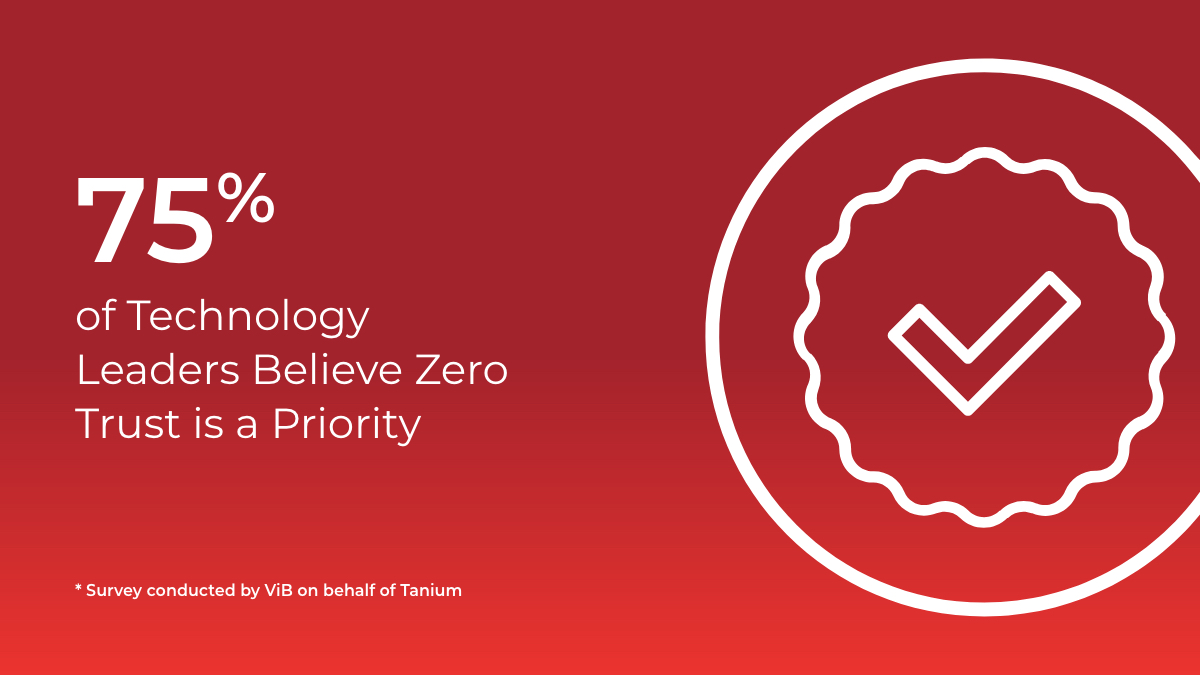
Zero trust is more than a buzzword — the majority of technology leaders take it seriously. 75% of technology leaders agreed or strongly agreed that implementing a zero trust framework is a priority to secure their new IT environments. Only 20% actively disagreed with this statement, and only 5% to 6% remained neutral on the subject.
Takeaway 5
70% of Technology Leaders are Using 11 – 50+ Different Endpoint Tools
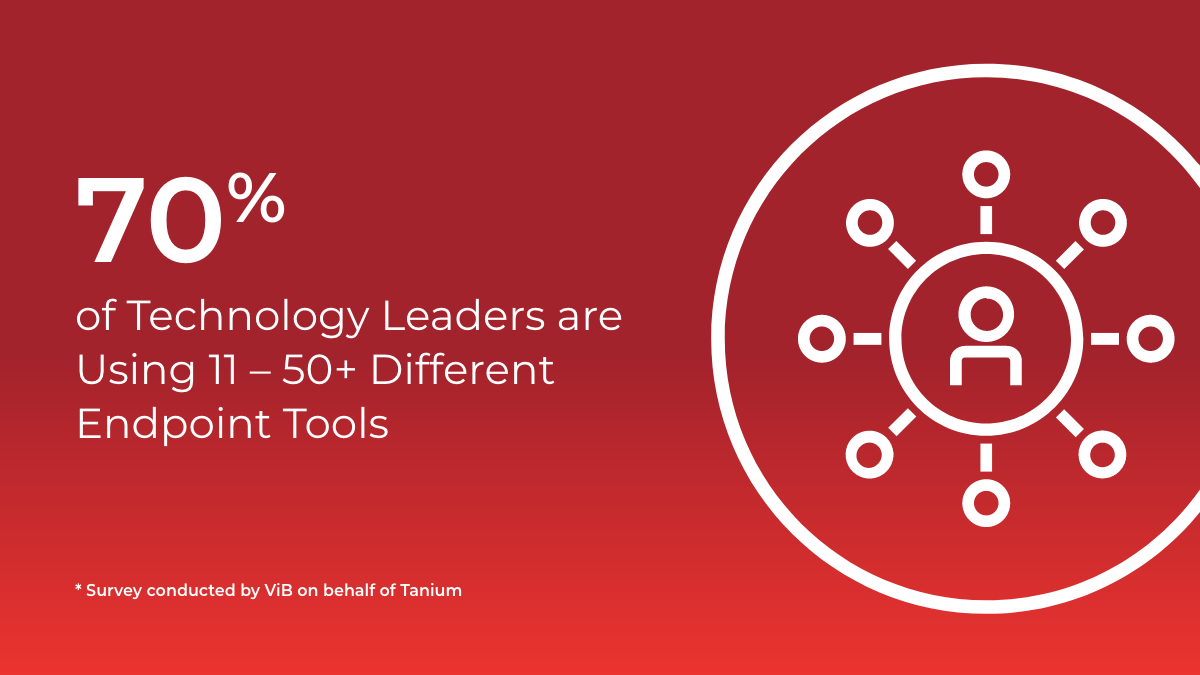 70% of technology leaders use anywhere from 11 to 50+ different endpoint security and operations tools. Nearly half (46%) use more than 20 tools, and 20% use more than 30 tools. 4% don’t even know how many tools they have.
70% of technology leaders use anywhere from 11 to 50+ different endpoint security and operations tools. Nearly half (46%) use more than 20 tools, and 20% use more than 30 tools. 4% don’t even know how many tools they have.
More than half of technology leaders (53%) consider this a problem, and are somewhat or extremely likely to rethink their point tool strategy and consolidate their endpoint operations and security tools. Only 25% are actively committed to continuing their point tool strategy.
Takeaway 6
59% of Technology Leaders Struggle to Manage Distributed Endpoints with On-Premises Solutions
Organizations now deploy a wealth of distributed endpoints, yet many still use legacy, on-premises infrastructure and endpoint management capabilities. The majority of technology leaders believe that they must modernize their infrastructure and capabilities to better manage and secure their new hybrid workforces.
Most technology leaders (59%) believe that legacy, on-premises infrastructure poses a major challenge to managing distributed endpoints in hybrid work environments.
Most (62%) also believe that IT must prioritize moving their endpoint management capabilities to the cloud. Only 12% actively disagreed with either statement.
Takeaway 7
72% of Technology Leaders are Making Security the Main Driver Behind Their IT Strategies and Roadmaps
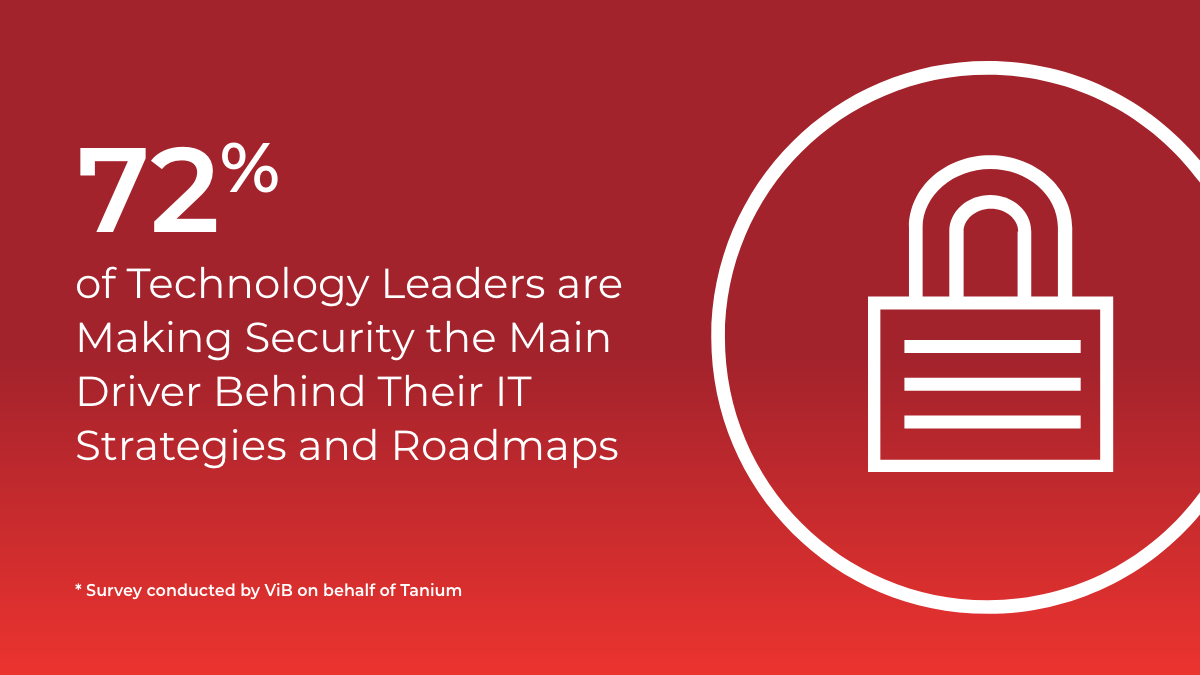
Only 28% of technology leaders are primarily concerned with business continuity, and focusing on how to use technology to drive their day-to-day operations.
- 72% of technology leaders directly or indirectly focus their IT strategies and roadmaps on how to secure their new hybrid workforces. Specifically:
- 22% focus on accelerating incident detection and response.
- 20% focus on regaining endpoint control to rapidly respond to vulnerabilities and incidents.
- 20% focus on being able to respond to external events.
- 10% focus on improving network visibility.
Takeaway 8
63% of Technology Leaders Have Visibility Into Only 85% or Fewer of Their Endpoints
Most technology leaders (63%) only feel confident that they have visibility into at least 85% or fewer of the endpoints on their networks. 25% feel confident they have visibility into at least 95% of their endpoints, and only 12% feel they have near-perfect visibility into at least 99% of their endpoints.
Takeaway 9
Only 44% to 54% of Technology Leaders Feel Confident Creating an Inventory of Remote and BYOD Devices
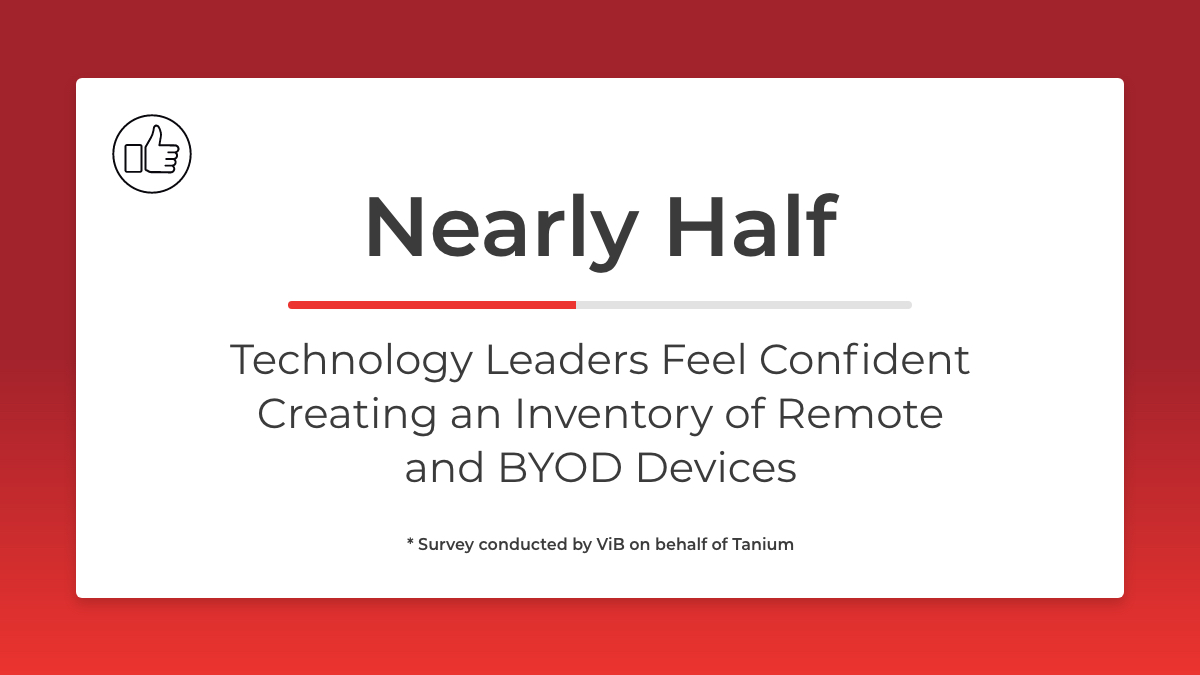
Technology leaders struggle to capture and inventory distributed assets. While 72% of respondents feel very or completely confident capturing and inventorying on-prem devices, only 54% feel confident inventorying remote devices, and only 44% feel confident inventorying bring your own device (BYOD).
Similarly, most technology leaders (58%) agreed or strongly agreed that it’s challenging to create a comprehensive picture of their assets. 54% said that their asset inventory process was too slow to create this picture.
Takeaway 10
52% to 55% of Technology Leaders Struggle to Detect and Respond to Breaches in Hybrid Environments
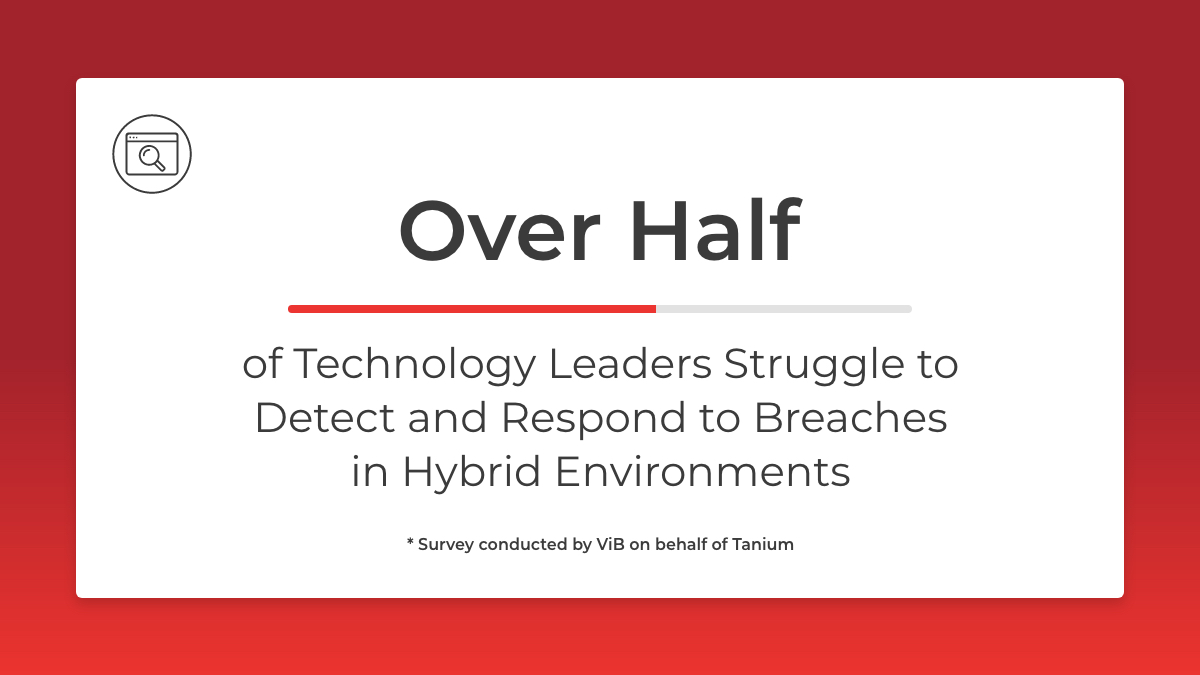
Only 48% of technology leaders feel very or completely confident in their ability to detect breaches in real time in their distributed or hybrid workforce. Less than half (45%) feel confident rapidly remediating that breach.
How to Overcome These Challenges and Prepare for What’s Next
At first, it looks like technology leaders face a wide range of challenges, and that each challenge demands its own strategies, tactics, and tools to overcome.
But once you look deeper, you see that all of these challenges can be solved through three simple priorities that today’s technology leaders must pursue.
To overcome today’s challenges, you must:
- Reestablish endpoint visibility and control over distributed endpoints.
- Rebuild your security to work beyond your perimeter.
- Modernize your IT infrastructure and endpoint tools.
To learn more about how to bring these priorities to life, take the first step: Sign up for your free cyber hygiene assessment and get your risk score.
Methodology:
This vendor-neutral survey was independently conducted by Virtual Intelligence Briefing (ViB) on behalf of Tanium, among 254 respondents working in the following areas: IT Infrastructure, Security | Director, VP/SVP, CIO, CISO, CTO | 1,000+ employees in North America.




